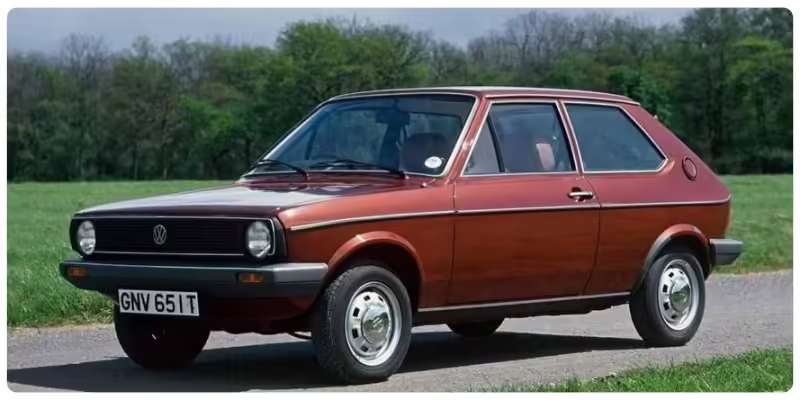Volkswagen Polo: A Journey Through Six Generations
The Volkswagen Polo, a highly acclaimed small car, has experienced six illustrious generations. As a prominent representative of Volkswagen, the Polo has played a crucial role in the automotive market. From its initial launch to the current sixth generation, the Polo has continuously evolved to meet the increasingly diverse needs of consumers.
First Generation Polo (1975-1980)
In 1975, Volkswagen introduced the first generation Polo, quickly establishing itself in the market. In just four years, Polo sales reached 500,000 units. The initial Polo was equipped with a 0.9L engine, producing a maximum power of 29kW. Later, Volkswagen released a 1.1L model.
In September of the same year, the Polo GT was launched, featuring a 1.3L engine with a maximum power of 44kW. This model can be considered the prototype of the Polo GTI.
In 1979, Volkswagen facelifted the Polo, enhancing the front bumper and adjusting the grille, which reduced air resistance at high speeds, thus increasing its speed.
Second Generation Polo (1981-1994)
The second generation Polo was officially released in 1981, offering two engine options: 1.1L and 1.3L. The design of the second-generation Polo emphasized sharper lines, giving it a more robust and sturdy appearance.
In 1986, the Polo GT (Polo GT40) was officially launched, providing consumers with more options.
In 1990, Volkswagen gave the second-generation Polo a significant facelift, making noticeable changes to its exterior. The iconic four-round headlights were replaced with two rectangular ones, giving the new Polo a more modern look.
Third Generation Polo (1994-2002)
In 1994, the third-generation Volkswagen Polo was officially released. This generation introduced four-door and five-door models, enhancing its practicality. In terms of power, it featured a 1.6L engine.
Compared to the second generation, the third generation Volkswagen Polo had significant exterior changes, shifting from straight-line designs to softer curves. This design was more aerodynamic, reducing the drag coefficient to 0.32, which improved fuel efficiency. Despite being slightly shorter in body length than the second generation, the interior space was more spacious.
1997 the Polo Variant was officially released, offering a trunk volume of 390 liters. The rear seats could be folded down, further enhancing storage capacity and practicality.
In 1998, the third-generation Polo GTI entered the market. This model was equipped with a 1.6L engine, delivering a maximum power of 88 kW and a top speed of over 200 km/h. Electronic safety features such as ABS and EBS became standard, but this model was limited to a production of 3,000 units.
By 1999, the total production of the Polo had reached 6 million units, achieving significant market success.
Fourth Generation Polo (2002-2009)
In 2002, the fourth generation Volkswagen Polo was officially released. The fourth generation Polo GTI was also launched during this period, equipped with a 1.8T engine with a maximum power of 110 kW.
The exterior design of the fourth generation Polo was more rounded, primarily featuring a 1.4L engine. Standard features included ABS, dual airbags, and power steering, with optional extras like ESP and navigation systems. Safety and comfort were further enhanced in this generation.
This generation also saw the introduction of sedan models, mainly targeting developing markets such as Nigeria, Ghana, Somalia, South Africa, Uganda, Morocco, and Algeria.
In 2005, Volkswagen gave the fourth generation Polo a facelift, adopting a U-shaped front design to replace the previous quad-headlamp design, making the car look more modern and stylish.
Fifth Generation Polo (2009-2017)
The fifth generation Volkswagen Polo featured a shift from the previous rounded design to sharper lines, paying homage to the classic design of the first generation Polo. The body size was longer and wider than the fourth generation, but the height was reduced. The rear design borrowed the square style from the Golf 6, moving away from the previous rounded shape.
In terms of power, the fifth generation Polo was equipped with a 1.2T turbocharged engine and a 1.6L diesel engine, offering Trendline, Comfortline, and Highline configurations. Transmission options included a 5-speed manual transmission (MT) or a 6-speed manual transmission (MT).
In 2012, the fifth generation Volkswagen Polo GTI was officially launched. This model had the same body size as the standard version but featured a more powerful engine, a 1.4TSI twin-charged direct injection gasoline engine with a maximum power of 178 hp, and a 7-speed dual-clutch transmission (DCT). Its CO2 emissions were only 139 grams per kilometer.
Sixth Generation Polo (2017-Present)
In 2017, Volkswagen officially launched the sixth generation Volkswagen Polo, offering three model choices: the hatchback, R-Line, and Polo GTI.
Exterior: The sixth generation Volkswagen Polo is equipped with LED lights, giving it a more youthful and stylish appearance, with an entirely new design for the whole car.
Power: The sixth generation Volkswagen Polo offers a variety of engine options, including 1.0L, 1.0T, 1.5T, and 2.0T engines. The transmission options include a 5-speed automatic transmission (AT), a 6-speed automatic transmission (AT), and a 7-speed dual-clutch transmission (DCT), providing consumers with diverse choices.
Interior: The sixth generation Polo features an integrated center console design, equipped with a large center screen and a fully digital instrument cluster, enhancing the technological feel inside the car. The vehicle also offers a leather multifunction steering wheel with adaptive cruise control system (ACC) buttons, further improving driving comfort and convenience.
Features: The sixth generation Polo comes with parking sensors, keyless start, automatic parking, and multiple driving modes. Overall, the features have been significantly upgraded compared to previous models.
Volkswagen Polo Made in China
2002-2009 (Fourth Generation VK Polo)
In 2002, SAIC Volkswagen introduced the fourth generation Polo into China for domestic production. Chinese consumers began to officially engage with the Polo. In 2003, the sedan version of the Volkswagen Polo was launched in China. The 2003 Polo in China came standard with a 1.4L engine, and a 1.6L engine was later added to enhance performance.
Subsequently, the facelifted version of the fourth-generation Polo was launched in the Chinese market. The updates included thicker bumpers at the front and rear and the addition of a roof rack.
2010-2018 (Fifth Generation VK Polo)
In 2010, Shanghai Volkswagen introduced the fifth generation Polo into the domestic market, which was launched in 2011. The 2011 Volkswagen Polo offered two power options: a 1.4L and a 1.6L engine. The fifth-generation Polo GTI (the 2012 Volkswagen Polo) was equipped with a 1.4TSI turbocharged petrol engine, producing a maximum power of 131 horsepower (later increased to a high-power 150 horsepower) and paired with a 7-speed DSG dual-clutch automatic transmission. Compared to the regular 2012 Polo, the 2012 Polo GTI featured a single-side dual exhaust outlet.
In 2012, the Cross Polo was launched in the Chinese market. This model was based on the fifth-generation Polo with a raised chassis by 15mm and added features such as the EPS electronic power steering system.
In 2014, the facelifted version of the fifth-generation Polo was introduced, featuring the new all-aluminum EA211 engine, making it the first model equipped with the EA211. This new Polo's exterior design bore some resemblance to the seventh-generation Golf, with a more refined overall style. The updated Polo came with a newly designed three-spoke steering wheel, and the center console featured a silver panel. The central control screen was upgraded to a touchscreen, available in 5-inch and 6.5-inch sizes, depending on the model.
The 2015 Polo GTI in the Chinese market was equipped with a 1.4TSI engine and a 7-speed DCT, differing from the 1.8TSI version available in other countries.
The 2018 Polo introduced additional internal features such as a body stability system, ESP, and a brake assist system, while the exterior remained unchanged.
2019-Present (Sixth generation VK Polo)
The sixth generation of the Volkswagen Polo was introduced in China in 2019. the body has grown significantly over the fifth generation and looks wider and more dominant. This also increases the space inside the car, making it more spacious. The sixth-generation Volkswagen Polo produced in China utilizes halogen lights, unlike the Volkswagen Polo's LED lights.
Configuration: The sixth-generation Volkswagen Polo comes with an 8-inch center screen and mechanical pointer gauges. The sixth-generation Volkswagen Polo was shown at the Frankfurt Motor Show with a full LCD dashboard.
Power: The Chinese version of the sixth-generation Polo is available with 1.0T and 1.5T engines, slightly different from the global version.
Although the Volkswagen Polo produced in China is different from the global version in terms of power or some features, it is more favorable in terms of price.
For more than 40 years, VK Polo has been constantly responding to market changes and consumer demand and is constantly updating and deriving more types of models. Polo still adheres to the original concept of being close to the public and will go even further in the future.
Related products:
Used 2019 VK Polo: 2019 Volkswagen Polo 1.5L Plus Hatchback
Used 2021 VK Polo: 2021 Volkswagen Polo 1.5L Plus Hatchback




